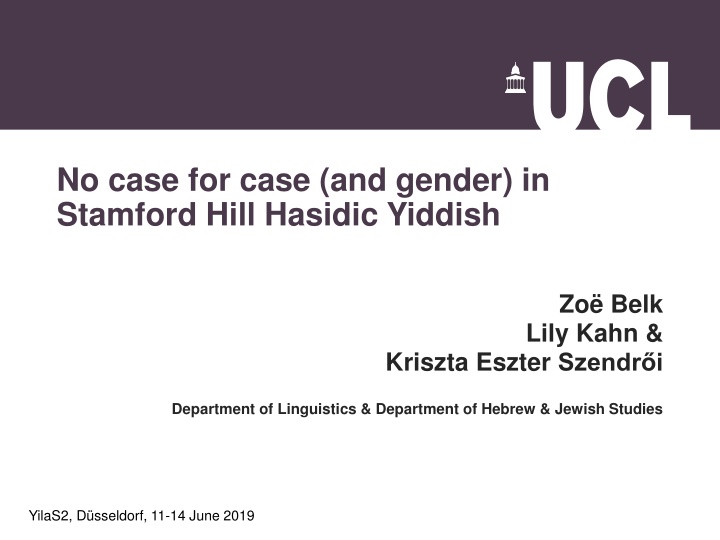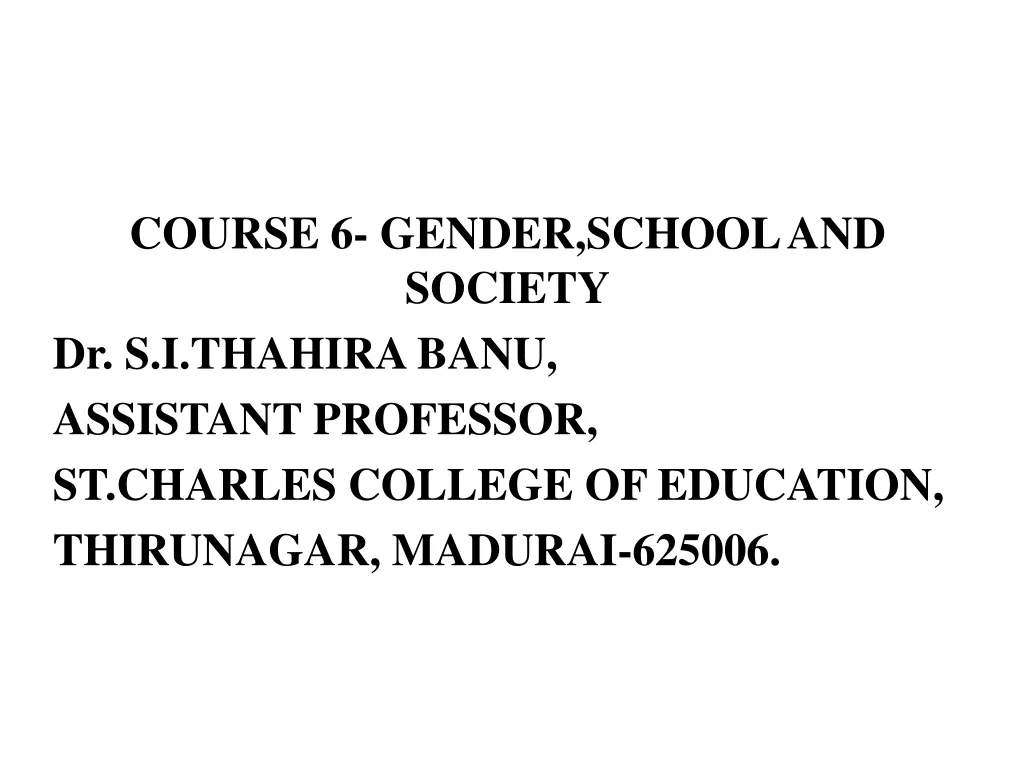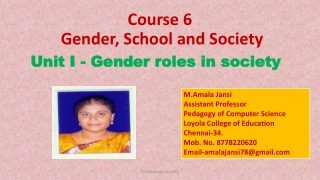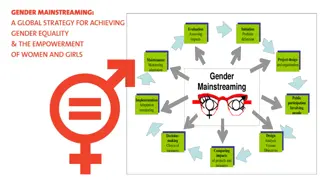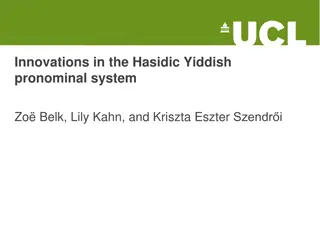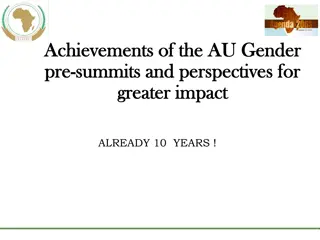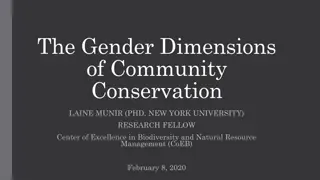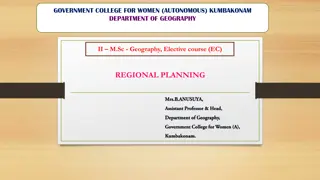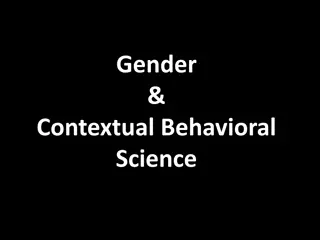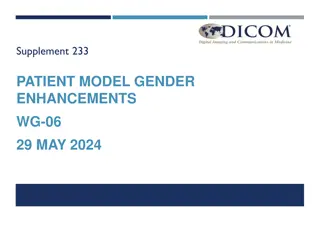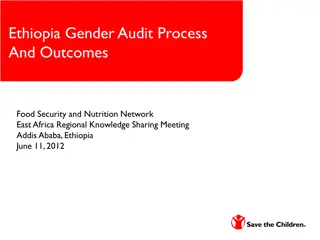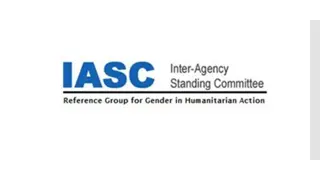Loss of Case and Gender in Hasidic Yiddish of Stamford Hill
Contemporary linguistic study reveals a rapid and pervasive shift in Hasidic Yiddish spoken in Stamford Hill, with a significant loss of case and gender distinctions. Elicited data and comparative analysis suggest a transformation in the mental grammar of Yiddish speakers in this community, challenging traditional linguistic frameworks.
Download Presentation

Please find below an Image/Link to download the presentation.
The content on the website is provided AS IS for your information and personal use only. It may not be sold, licensed, or shared on other websites without obtaining consent from the author.If you encounter any issues during the download, it is possible that the publisher has removed the file from their server.
You are allowed to download the files provided on this website for personal or commercial use, subject to the condition that they are used lawfully. All files are the property of their respective owners.
The content on the website is provided AS IS for your information and personal use only. It may not be sold, licensed, or shared on other websites without obtaining consent from the author.
E N D
Presentation Transcript
No case for case (and gender) in Stamford Hill Hasidic Yiddish Zo Belk Lily Kahn & Kriszta Eszter Szendr i Department of Linguistics & Department of Hebrew & Jewish Studies YilaS2, D sseldorf, 11-14 June 2019
Introduction o vast majority of current day Yiddish speakers are Haredi o most Yiddish-speaking Haredi Jews are Hasidic (Isaacs 1999: 12) o currently an estimated 750,000 Hasidic Jews globally (Biale et al. 2017) o largest communities in Israel (Meah Shearim, Bnei Brak); the US (Boro Park area); in Antwerp, Belgium; and in London s Stamford Hill (ca. 40,000 people) o in SH, over 75% of adults and children are fluent in Yiddish, and over 50% use it as the main language at home (Holman & Holman 2002) (see Isaacs (1999:13) for similar claims about the other communities) o linguistic research on Hasidic Yiddish is scarce, and for Stamford Hill Hasidic Yiddish practically non-existent (pace Mitchell (2006), a sociocultural study)
Our claim o in contrast to Standard Yiddish and pre-War spoken dialects, contemporary SHH has no case or gender on nominals o other Hasidic communities seem to have also lost case and gender, but we have no systematic data o many have noted (advanced) morphological syncretism in the case and gender paradigms (Krogh (2012), Assouline (2014), Sadock & Masor (2018)) o we argue for full loss of the notion of case and gender in the mental grammar of contemporary SHH Yiddish speakers o this is rapid and pervasive language change: the linguistic character of the language is altered (cf. Middle vs. Modern English, where the same change happened over 400 years)
Standard Yiddish case and gender DAT ACC NOM MASC dem gutn der guter good FEM der guter di gute NEUT (indefinite) (a) gut ( ) NEUT (definite) dem gutn dos gute PL di gute
Elicited data background information o 12 native Yiddish speakers born and raised in Stamford Hill other Hasidic communities seem to have also lost case and gender, but we have no systematic data 3 male, 9 female age range: 20-70+, mostly 20s Hasidus: Satmar, Vizhnitz, Belz, Bobov, Slonim geographical origin: GP generation Hungary, Poland, Vienna, France, Israel, Iraq, UK o tasks o other Hasidic communities seem to have also lost case and gender, but we have no systematic data online translation task Pictionary writing task: 8 singular 3 plural nouns in three genders (Swadesh list and frequent nouns) dictation task: same 33 nouns with modifying adjectives in all 3 cases copy editing task: excerpt from Tribune doctored with case/gender omission and commission errors and typos judgment task: same 33 nouns provided with all 4 determiners in subject, object and P-object positions o
Published material background information o Tribune corpus other Hasidic communities seem to have also lost case and gender, but we have no systematic data 5 articles from the Yiddish section of the Stamford Hill weekly Hasidic newspaper o o Varshever corpus (Geller 2001) other Hasidic communities seem to have also lost case and gender, but we have no systematic data comparable section of the spoken interviews with pre-War Warsaw speakers o Reb Nahman s tales o other Hasidic communities seem to have also lost case and gender, but we have no systematic data Tales 1, 2, 3 and 9 out of 13 tales o o recordings of Hasidic rebbes other Hasidic communities seem to have also lost case and gender, but we have no systematic data 15-minute excerpts from droshes of Naftali Tsvi Halberstam (b. 1931, Bobover rebbe), Y. Y. Halberstam (b. 1905, Sanz-Klausenburger rebbe), Joel Teitelbaum (b. 1887, Satmar rebbe) o other Hasidic communities seem to have also lost o
Overview o gender other Hasidic communities seem to have also lost case and gender, but we have no systematic data historical comparison data: Hasidic written & spoken sources; Varshever corpus (Geller 2001) elicited data: spoken & written published written data o o case other Hasidic communities seem to have also lost case and gender, but we have no systematic data historical comparison data elicited data: spoken and written published written data o o conclusions & outlook
Gender key findings consistent gender marking in historical written and spoken data no gender marking in spoken data inconsistent gender marking in elicited and published written data
Historical comparison data key findings data: Hasidic written and spoken sources from pre-War other Hasidic communities seem to have also lost case and gender, but we have no systema speakers (R. Nahman, Hasidic rebbes, Hasidic badkhn) o nominal gender agreement fully corresponds to the Standard Yiddish and traditional Mid-Eastern and South- Eastern dialect paradigms masculine, feminine, and neuter genders this holds for written and formal spoken data more live spoken pre-War data being collected
Historical comparison data Varshever corpus (Geller 2001) other Hasidic communities seem to have also lost case and gender, but we have no systema o MASC (total: 96) FEM (total: 86) NEUT (total: 41) 96% 0% 0% 0% 4% 100% 0% 0% 0% 0% 100% 0% Total rate of gender errors 2.3% Represents two/three speakers; consistent strategy (using prescriptively correct gender!) Existence of neuter gender (11 tokens/44)
Elicited spoken data: no gender marking on determiners or adjectives MASCULINE FEMININE NEUTER 1a. b. c. N O M d ureme man the poor man d alte fro: the old woman d alte purfolk the old couple 2a. b. c. d beste flaysh the best meat A C C d ureme mentsh the poor person a gite besi good news 3a. b. c. mit a brayte ofene harts with a wide open heart D A T mit d ziste tsimes with the sweetest tsimes af d tserisen shvartse kapote at the torn black kapote
Elicited spoken data: attributive marking 1 d houz iz groys/*groys . the house is big/big-E The house is big. 2 frayhayt iz vikhtik/*vikhtik . freedom is important/important-E Freedom isimportant. 3 ints hobn gefarbt d tir royt/*royte. we have painted the door red/red-E We painted the door red.
Elicited written data: methods PICTIONARY TASK Write name of picture into schema: __________ _______ Should give us gender of nouns, in principle 12 imageable nouns in MASC, FEM, 8 in NEUT about half from Swadesh list, half very frequent nouns, some Hebrew origin words
Elicited written data results MASC (total: 96) FEM (total: 86) NEUT (total: 41) other Hasidic communities seem to have also lost case and gender, but we have no systema o 61.5% 24% 1% 13.5% 65% 30% 0 4.5% 46.5% 24.5% 10% 19.5% total rate of gender errors is 50.5% individual strategies vary widely and sometimes change from page to page within an individual - across-the-board (sometimes even with plurals) - across-the-board - and used more or less randomly - random mix of , , our 70+ participant, incomplete data: 100% (5) M ; 80% (5) F ; 0% (1) N ,
Published written (Tribune) data: inconsistent gender marking total number of gender-marked NPs in corpus 148, of which 133 have a set gender in Standard Yiddish (i.e. not English borrowings) altogether 98 different nouns occurred only two items occurred with , most nouns appear to be used as masculine or feminine total rate of gender errors is 22%
Published written (Tribune) data: inconsistent gender marking NOMINATIVE / MASCULINE (total: 19) FEMININE (total: 11) NEUTER (total: 2) 89.5% 10.5% 0% 27.5% 63.5% 9% 50% 50% 0 MASC standard forms are boosted by a very high number of forms overall, which happen to correspond to standard gender in the NOM.MASC. practically no NEUT examples in the NOM, but other cases show lack of use of many commission errors do not reflect a consistent gender assignment that is different from the standard, as gender assignment is variable even for the same nouns
Published written data: breakdown of findings Tribune corpus (%ages calculated over identifiable gender only) der.Nom dem.Nom di.Nom dos.Nom MASCULINE 1 (100%) 2 (20%) 0 84% of which animates 10 0 1 0 FEMININE 16% 0 1 (50%) 7 (70%) of which animates 1 0 2 0 NEUTRAL 0 0 1 (10%) 1 (50%) of which animates 0 0 0 0 indeterminate 0 0 2 0
Published written data: breakdown of findings Tribune corpus (%ages calculated over identifiable gender only) der.Nom dem.Nom di.Nom dos.Nom MASCULINE 1 (100%) 2 (20%) 0 16 (84%) 10 of which animates 0 1 0 FEMININE 3 (16%) 0 1 (50%) 7 (70%) 2 of which animates 1 0 0 NEUTRAL 0 0 1 (10%) 1 (50%) 0 of which animates 0 0 0 indeterminate 0 0 2 0 dem.Acc di.Acc dos.Acc der.Acc dem.Prep der.Prep di.Prep dos.Prep 6 (40%) 0 2 (100%) 3 (38%) 5 (14%) 0 6 (67%) 20 (77%) 1 0 0 2 4 1 0 0 2 (22%) 0 0 1 (4%) 30 (81%) 0 7 (47%) 5 (63%) 0 0 0 0 0 0 0 0 1 (11%) 2 (13%) 0 0 2 (5%) 3 (100%) 1 (100%) 5 (19%) 0 0 1 0 0 0 0 1 1 1 0 0 4 1 6 0
Gender: summary Gender error rate 100% 50.5% 22% 2.3% 0% elicited spoken data elicited written data published written data (Tribune corpus) Varshever corpus historical Hasidic data (R. Nahman, rebbes) Oh, but Yiddish is not like French or Hebrew, it does not have masculine and feminine! der, di, de no idea.. should be used for bigger objects, while should be used for smaller objects, e.g. , textbook, Hotsa at Chay 1999: 33) - Upon reflection you would write di car and dos tish. - Not der tish? - Hmm, both sound right.' (school
Case key findings consistent case marking in historical written and spoken data no case marking in spoken data inconsistent case marking in elicited and published written data
Historical comparison data key findings data: Hasidic written and spoken sources from pre-War speakers (R. Nahman, Hasidic rebbes, Hasidic badkhn) case fully corresponds to the Standard Yiddish and traditional Mid-Eastern and South-Eastern dialect paradigms nominative, accusative, and dative cases in all three genders this holds for written and formal spoken data more live spoken pre-War data being collected
Historical data Varshever corpus Varshever corpus (%ages calculated over identifiable gender only) der.Nom dem.Nom di.Nom dos.Nom MASCULINE 0 0 0 23 (96%) 22 of which animates 0 0 0 FEMININE 1 (4%) 0 0 9 (100%) 3 of which animates 1 0 0 NEUTRAL 0 0 0 11(100%) 3 of which animates 0 0 0 indeterminate 0 0 0 0 dem.Acc di.Acc dos.Acc der.Acc dem.Prep der.Prep di.Prep dos.Prep 0 0 0 0 2 (8%) 0 3 (100%) 19 (58%) 0 0 0 0 6 0 0 0 0 0 0 0 21 (84%) 0 10 (100%) 6 (100%) 0 0 0 0 0 1 5 0 0 0 0 0 2 (8%) 0 1 (100%) 14 (42%) 0 0 1 0 4 0 0 0 0 0 1 0 2 1 6 0
Historical Varshever corpus clear gender and case system, roughly in line with Standard Yiddish and traditional Mid-Eastern and South-Eastern dialect paradigms feminine dative usually realized as PREP+di, although PREP+der also attested 2/2 intimate nouns appear with ACC/DAT ending; 0/2 appear in Tribune corpus 0/21 mismatched case/gender endings; 5/32 (15%) in Tribune corpus
Elicited spoken data: no case marking on determiners or adjectives MASCULINE FEMININE NEUTER 1a . b . c. N O M d ureme man the poor man d alte fro: the old woman d alte purfolk the old couple 2a . b . c. d beste flaysh the best meat A C C d ureme mentsh the poor person a gite besi good news 3a . b . c. mit a brayte ofene harts with a wide open heart D A T mit d ziste tsimes with the sweetest tsimes af d tserisen shvartse kapote at the torn black kapote
Elicited written data: dictation task No = 346 standard case marking standard case, nonstandard gender 34.5% standard gender, nonstandard case 11% nonstandard case, nonstandard gender 17.5% Ungrammatical form in standard 22% 15% mean 17%-34% 2.5% - 54% 7.5% - 13% 0% - 32% 0% - 68% range individual strategies again vary widely: PART_1: only - PART_2: mostly ( - ) 28 forms expected overall, 60 forms found including forms in all cases, including NOM; 11 of 18 plural forms were standard forms ungrammatical in the standard, mostly only 2 instances of matched agreement of the no - forms used at all. forms 32% standard, 0% ungrammatical forms 34% standard, 7% ungrammatical forms in all cases; - , but 7 out of 18 (39%) occurred with f - , but some - only 1 of which is F.DAT. - . -
Elicited written data: copy editing task Adapted from article in the Yiddish Tribune, 9 March 2017
Published written (Tribune) data: inconsistent case marking possible gender variant all genders standard case other MASCULINE (total: 61) FEMININE (total: 56) NEUTER (total: 16) 69% 18% 13% 34% 12.5% 53.5% 44% 25% 31.5% other forms include NOM , ACC , P+ - possible gender variant involves forms corresponding to the standard grammar but assuming a non-standard gender assignment (e.g. the whole house ) MASC standard forms are boosted by a very high number of forms overall, which happen to correspond to standard gender in the NOM.MASC. majority of other FEM forms involve P+ ,mixed agreement , \ -
Case summary historical data: nominative, accusative, and dative in all three genders non-standard use of di in Varshever FEM.DAT elicited spoken data shows no case or gender marking elicited written data shows no awareness of purpose of case endings, allowance of multiple correct forms published written data shows high degree of inconsistency, including novel forms e.g. NOM , ... . , ,
Conclusions we are witnessing rapid, pervasive, general language change rapid: (father b.1923 -son b.1963 data differences) pervasive: syntactic effects - OVS sentences are not accepted - V-O adjacency is required general: previous work, Krogh (2012), Assouline (2014), Sadock & Masor (2018), and our own ongoing fieldwork shows the same changes in Antwerp, US, and Israel
Conclusions the Shoah and associated geographic dispersal of the Ashkenazi people, exposing Yiddish to new contact languages and to dialect levelling internal causes: underlying spoken dialect had final r deletion and partial ACC-DAT syncretisms (Krogh 2018) possible broken transition? first post-War generation had many L2 speakers predominantly spoken usage, little formal education, lack of connection to written Yiddish (cf. Pennsylvania Dutch)
! Thanks to Eli Benedict, Mendy Cahan, Shifra Hiley, Shmuel Hiley, and Izzy Posen and the Yung Yidish Library, Museum and Cultural Centre This research is funded by the Arts and Humanities Research Council.
Published written (Tribune) data: examples lekoved der ibergegebene menahel in.honour.of the.M.NOM devoted.F.NOM/ACC director in honour of the devoted director 11a. b. oyf der linke zayt on the.M.NOM left.F.NOM/ACC side on the left side hot men opgekoyft dem dernebndign hoyz have one up.bought the.M.ACC nearby.M.ACC house they bought up the nearby house britishe premierministorshe British.F.NOM/ACC prime minister.F British Prime Minister Theresa May 12a. b. 187 di gantse hoyz numer 187 whole.F.NOM/ACC house number 187 the whole of house number 187 der britisher premier ministorshe terisa mey the.M.NOM British.M.NOM prime minister.F Theresa May 13a. b.
Historical Hasidic written data: R. Nahmans tales MAS FEM NEUT nor dos hemd except the.N.NOM shirt except their shirt hot zikh der keyser gelozt has REFL the.M.NOM emperor let the emperor went out 1a. b. c. N O M hot di malke has the.F.NOM queen so the queen shlofn dem gantsn mes- les to.sleep the.M.ACC whole- M.ACC 24-hour.period sleep the whole day and night vayzn dos ort to.show the.N.ACC place to show him the place 2a. b. c. A C C hot er im dertseylt di gantse mayse has he him told the.F.ACC whole-F.ACC story so he told him the whole story moydiye geven dem meylekh inform were the.M.DAT king informed the king of it mit a kleyn shifl with a small.N.DAT boat-DIM with a small boat 3a. b. c. D A T af der velt into the.F.DAT world into the world
Historical Hasidic spoken data: rebbes MASCULINE er hut gevist az der khayrem iz nisht gerekht he has known that the.M.NOM ban is not right he knew that the ban was wrong FEMININE di shtu t i: geven a misnagdishe shtu t the.F.NOM town is was a mitnaggedic-F.NOM town the town was a mitnaggedic town husti gemakht yeyde halbe shu have.you made every- F.ACC half-F.ACC hour you did [it] every half an hour NEUTER dus ershte mul the.N.NOM/ACC first-N.NOM/ACC time the first time 1a. b. c. N O M 2a. b. c. haltn dem yontef to.keep the.M.ACC festival to keep the festival A C C a halb yu r a half.N.ACC year half a year 3a. b. c. ofn gantsn gif on-the.M.DAT whole-M.DAT body on his )lit: the( whole body D A T me shluft of der erd, nisht of kayn bet one sleeps on the.F.DAT ground, not on NEG bed they sleep on the ground, not in a bed mit a groys kol with a big.N.DAT voice with a loud voice
Elicited written data: judgment task NOM ACC DAT stan- dard non- stand. ACC/ DAT stand. non- stand. NOM stand. non- stand. NOM OK 33% 32% 4.5% 15% 23% 70.5% 51% 54.5% 25% * 66% 68% 94.5% 85% 77% 29.5% 48.5% 45.5% 75% case in assuming that gender is also standard non-standard is a case form that could correspond to the given case assuming a non-standard gender assignment the third column contains forms that could not be the given case no matter what gender assignment is used 12% of the answers were marked as ? standard forms correspond to the forms used in Standard Yiddish in the given
